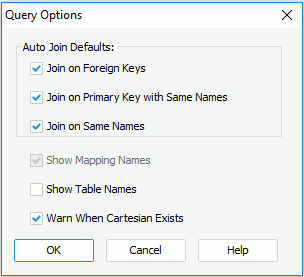Query Options Dialog
The Query Options dialog appears when you select Menu > Query > Current Query Options in the Query Editor. It helps you to specify the settings for a query. See the dialog.
The following are details about options in the dialog:
Auto Join Defaults:
Specifies the options for auto joins.
- Join on foreign keys
Specifies to automatically join tables in a query through a reference from Table A to a primary key in Table B. For example, an order form in Table A shows information on purchases that are made by a customer with a primary key of CustomerID. The customer ID # refers to a record in Table B which lists a specific address, phone number, name, and so on for the customer. The CustomerID in Table A is a foreign key because it links the customer's ordering information in Table A to the customer's information in Table B using the CustomerID field. - Join on primary keys with same names
Specifies to automatically join tables in a query through a field or a combination of fields that uniquely and specifically identifies a record. For example, the OrderID may be the primary key in a table for Orders and also for Payments. - Join on same name
Specifies to automatically join tables in a query through a link between two columns of the same name in two different tables. This often creates many invalid joins such as Amount that appears in both tables.
Show Mapping Names
If selected, the full names of the columns in the tables will be displayed in the criteria panel of the Query Editor.
Show Table Names
If selected, the table that each column belongs to will be displayed in the criteria panel of the Query Editor.
Warn When Cartesian Exists
Specifies whether or not to display a warning when a Cartesian exists. A Cartesian product is used when tables are added to the query with no join specifications.
For example, Table A has three values: A, B and C and Table B has three values: 1, 2 and 3. Value A matches value 1, value B matches value 2, and so on. This is a specific match.
A Cartesian product would have value A matching with 1, 2 and 3, and value B matching with 1, 2 and 3, and so on. Depending on the data values Cartesian products can produce large datasets since each record in Table A matches every record in Table B.
OK
Applies the settings for the query and leaves the dialog.
Cancel
Does not retain the settings for the query and leaves the dialog.
Help
Displays the help document about this feature.
 Previous Topic
Previous Topic
